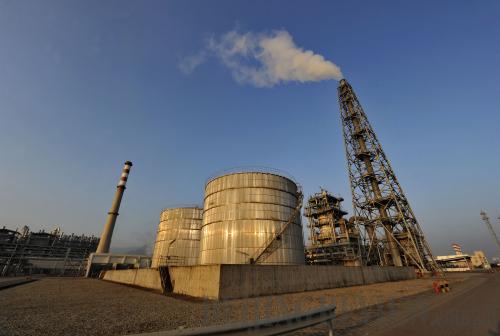|
 |
|
BLACK GOLD: Guangdong's Oil refinery capacity is expected to reach 100 million tons during the 12th "Five-Year Plan" (2011-15). Pictured is a CNOOC-Shell Petrochemicals Co. Ltd. plant in Guangzhou, capital of Guangdong Province (LIU DAWEI) |
Numbers of the Week
246 million
Last year, 246 million mobile phones were sold in China, due to the popularity of 3G services and smart phones, said the Beijing-based research firm Analysys International.
94.3 trillion yuan
The total assets of China's banking sector reached 94.3 trillion yuan ($14.3 trillion) at the end of 2010, up 19.7 percent from a year earlier, said the China Banking Regulatory Commission.
TO THE POINT: China has maintained its attractiveness to foreign investors with foreign direct investments leaping 17.4 percent last year. Meanwhile, domestic companies are rushing to extend their global reach, boosting outbound direct investment to a record high. Despite gloomy stock markets, China has taken a leading position among global IPO markets. The logistics industry picks up momentum, though problems remain. Home appliance giant Haier has fared well, with profits soaring 78 percent last year.
By HU YUE
FDI Holding Up
For investors across the globe, China remains a favorite destination.
The country received a record $105.74 billion in foreign direct investment (FDI) in 2010 into its non-financial sectors, rising 17.4 percent from the previous year, said the Ministry of Commerce (MOFCOM). A total of 27,406 foreign-funded enterprises were approved last year, up 16.9 percent year on year.
Meanwhile, the structure of the FDI continues to improve. The central and western regions accounted for 15 percent of FDI inflows last year, up 1.2 percentage points from a year earlier. In addition, 46.1 percent of the foreign capital went to the service sector, compared with 42.1 percent in 2009.
China is continuously optimizing its investment environment, enhancing appeal to foreign investors, said the ministry.
In April 2010, the State Council issued a string of new rules, allowing local governments a larger say in approving FDI projects and encouraging foreign capital into hi-tech, modern service, and new energy industries.
The American Chamber of Commerce in Shanghai said in a recent report 87 percent of U.S. companies in China reported revenue growth last year, surging from 47 percent in 2009.
Finding enough qualified staff was the biggest business challenge, and competition is picking up not only between U.S. and other foreign companies but between U.S. and Chinese companies.
Optimism regarding the China market continued. About nine out of 10 U.S. companies in China forecast a revenue increase for 2011, said the report.
Venturing Offshore
With ambitions to make global names for themselves, Chinese companies are looking to expand their footprints beyond China's borders.
China's outbound direct investment (ODI) in non-financial sectors hit $59 billion last year, up 36.3 percent from 2009, said the MOFCOM.
The commercial service sector has been the most coveted area for Chinese investment, followed by the mining and manufacturing industry.
The investing spree comes amid the unprecedented global recession that has forced multinationals to ease back on expansions. Global flows of foreign direct investment grew a minuscule 0.7 percent to around $1.12 trillion in 2010, said the United Nations Conference on Trade and Development.
Meanwhile, mergers and acquisitions became a convenient route for China to step onto the world stage. The MOFCOM said Chinese companies were responsible for $23.8 billion worth of overseas merger and acquisition deals last year, accounting for 40.3 percent of the total ODI.
Apart from strong interest in natural resources, Chinese buyers are increasingly looking to purchase technological know-how and learn cross-cultural experiences, said Xing Houyuan, Director of the Research Center for Overseas Investments under the Chinese Academy of International Trade and Economic Cooperation, a think-tank affiliated to the MOFCOM.
IPO Rush
China maintained its leading position in global IPO markets in 2010, despite stock volatility, said the international accounting firm PricewaterhouseCoopers (PwC), in a recent report.
The Shanghai and Shenzhen stock exchanges witnessed 349 IPOs last year, raising a combined 478.3 billion yuan ($72.7 billion) last year, an increase of 155 percent year on year.
Small and medium-sized enterprises (SMEs) picked up momentum—the Shenzhen SME board attracted 204 IPOs, which raised 202.7 billion yuan ($30.8 billion). The growth enterprise board ChiNext, also boomed with 95.4 billion yuan ($14.5 billion) raised via 117 new listings.
It showed that the development of Chinese SMEs has entered a growth boom, promising to become the main driving force for capital markets in the future, said Frank Lyn, PwC China markets leader.
In addition, information technology and telecom companies accounted for 35 percent of IPOs on the ChiNext. It seems that capital resources have been weighted in favor of growth and innovation-based enterprises, said the report.
However, due to the potential lack of major IPOs in 2011, PwC forecasts that listing exercises this year may not raise funds as large as those in 2010.
| 